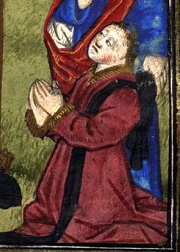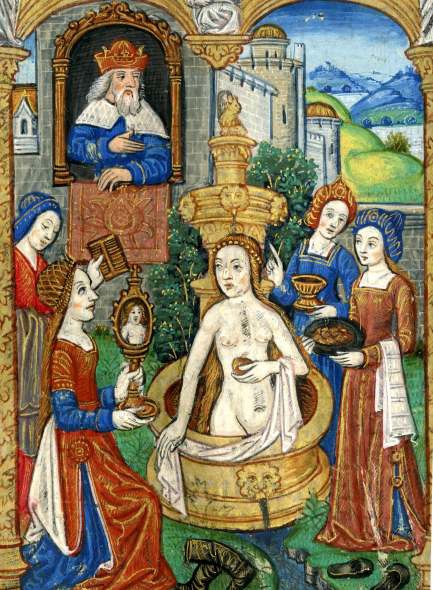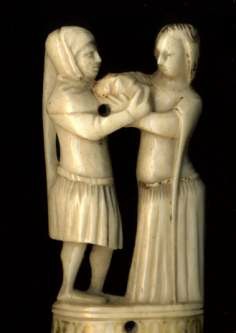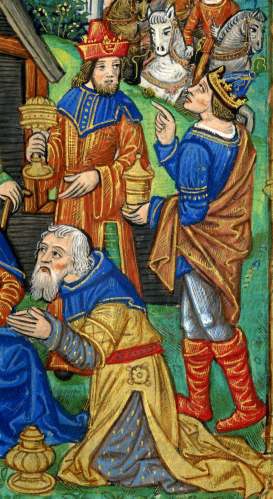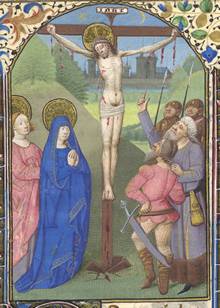Text quoted from
"The Book of Hours An Introduction"
Authors. D. Villani G. Solmi A. Balistrieri
Editore NOVACHARTA 2019
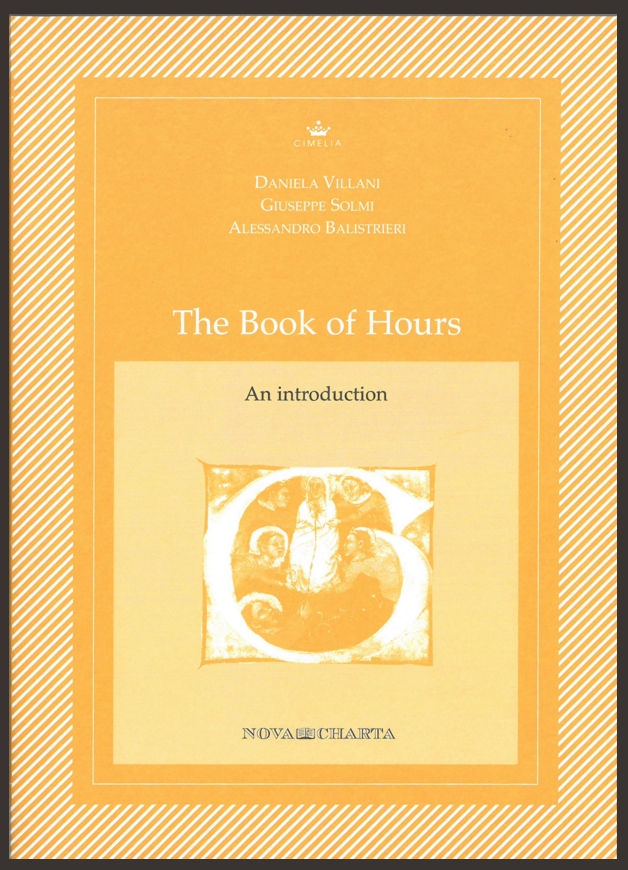
The study of the style of European garments between the 14th and 16th centuries is afflicted with an objective difficulty, as well as the scarcity of pieces that have reached our times, a problem that is further complicated by the lack of a common European vocabulary that denotes the terms of medieval fashion.

Everyone was bound to dress in the garments of their own social class without going over the set limits. The ostentation of richness was based on the complicit exhibition of clothes tailored in a way that would impede any kind of manual labour. Clothing worn by workers and peasants were cut to an essential size, functional for work; they were dull colours or even “colourless”, coloured only by the natural tint of the material.
The study of images is very useful seeing as it is precisely from the miniatures that we are able to draw out the most significant deductions on the clothing of peasants. Rural scenes in particular, such as the Annunciation to the Shepherds provide us with lots of information. Everywhere the clothing of the poor and of the peasants is reduced to the essentials: a garment for work and a garment for feasts. Peasants are often represented in a simple tunic tied at the hip or at most covered by a surcot. Women wore a blouse and a surcot which the sleeves of the blouse sprung out. Even the colours-usually solid colour of white black and grey, contribute to the identification of shepherds. Under these aspects, however, the Annunciation of the Shepherds can represent an exception: often figures dressed in blue and red garments can be found, that symbolise the solemnity of the day of the coming of Christ.
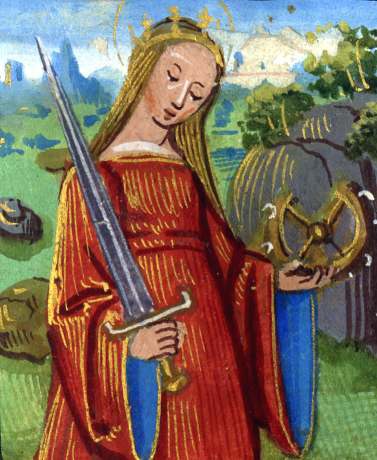
Before the peak of the Middle Ages there was never a legislation created to discipline clothing, but starting from 13th century there were special rules issued known as “Sumptuary Laws”, supported by preachers and moralists who targeted stereotypical female vanity.
FEMALE clothing
The wardrobe was made up for both sexes by garments that were worn “in layers”: a shirt, a light and long linen down to the ankle, the gamurra and the guarnacca or surcot.
These garments remained functionally well-defined over time, even though they assumed different names or styles according to the geographical area in which there were produced. The ideal female of the 14th century was a thin and willowy figure with blonde hair, an oval face and barely discernible bust. The Italian women of the XV century wore a gamurra on their chemises, also called cotta, a daily garment that was worn by putting it on over the head. Sleeves, one of the most important accessories, being very subjected to their use, soon became detachable.
Another garment that was habitually worn in the XIV century was the so called cipriana with an ample neckline that went from shoulder to shoulder. In Italy guarnacca was worn on top of the most “intimate” clothes in winter, an elegant garment with detachable sleeves. The Italian term did not find correspondence in the other languages gathered in Europe, where it was sometimes translated with the French term houppelande-whose Italian counterpart was instead the word pellanda-, a garment that appeared in France at the end of the XIV century. Worn by both men and women the houppelande was a garment rich in excellence, a prerogative of the mid-high French classes that could afford the expense of a notable amount of fabric and lining of fur.
Surcotes were in France very common. The French term signified “above the cotte”.
MALE clothing
During the first centuries of the early Medieval period, male garments were not different from the female but with the passing of decades the differences became ever more evident. Generally the garments worn “underneath” were a shirt or tunic, hose or breeches. In order to avoid depicting the privates of venerable saints in the iconography of the martyrs and crucifixions, many types of this garment were illustrated, called sarabule: tight at the waist and with strings tied at the front.

The shirt called interula or tunic was made in canvas or linen and the styles varied but most popular model was the shape of a tunic worn down to the knee. According to the norms of the most well-to-do classes, the shirt should never remain in plain sight: it was only allowed around the collar, at the wrists and through the slits of the doublet.
A real revolution occurred at the beginning of the XIV century when men allowed to show their legs, dressing in short and adherent clothing. The fashion for uncovered legs lasted until XIX century when it was preferred to cover men’s leg again by means of the first breeches at the start of the Romantic Era.
A true revolutionary garment of the late Middle Ages remained the doublet or in French pourpoint. It appeared in France between the XIII and XIV centuries and remained a garment of excellence for the entire of the following century. It was a sort of waistcoat often lined with cotton wool that was modelled to the silhouette of the wearer and in addition to the clear aesthetic value, functioned to soften blows received in battle. It was used at many times of the day and usually tied at the front by a line of buttons that divided the bust into two parts.
Different types of surcoat could be worn over the doublet in Italy, such as cioppa or the guarnacca, quite long and sometimes with splits on the sides to help when riding. We find surcoats of this types in French miniatures, made with half sleeves that allow a glimpse at the garment or doublet underneath. A short medieval garment required, in order to reveal the form of the male leg, an adherent and well-stretched hose: looseness was also a sign of disorder and shabbiness. The hose could be a single garment together with shoes, in which case they were called soled hose, that is with a sole of leather.
Real shoes became more popular with the passing of time, while the socks developed into the function that they have today. They were originally placed on separate legs and were tied to the doublet with strings and laces, while towards the end of the 14th century, in response to critiques of immodesty, some “anonymous genius” had the idea to sew the two legs to a central piece of triangular cloth placed to cover the pubic region. This mobile piece, at the end of the XV century became known as a codpiece: the button flap of the hose. Footwear was generally tailored in leather,usually in lambskin.

The typical and very popular pointed shoes called poulaine appeared between the XIII and XIV centuries and had two centuries of use. Similarly to what has been for the train of women’s clothes, the length of the point of these shoes was related to the social class of the wearer: those of kings were not under any kind of limitation.
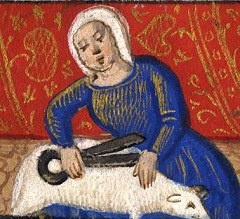
An important innovation in the XIV century was the cale de toile, a cap in white canvas with two strips that were tied under the neck. It was worn by people belonging to all social classes. A hood expanded into a shrug cape appears around the end of the XII century and it is very common to find it depicted in medieval miniatures. The hood covered the head by winding around and completely hiding the hair, called chaperon.
In the course of the XIV century a strange feature was imposed on the posterior of the hood which would later become its principle characteristic: a long pointed tail called a liripipium that could be tied on the head. A few words on bags a very widespread accessory given the lack of pockets in clothing: they were made in leather and could have a rectangular shape (scarselle). Scarsella was the Italian name for the bag that was carried tied to a belt, but among the Shepherds represented in French miniatures was a particular bag of halfmoon shape was very popular called besace banana.
